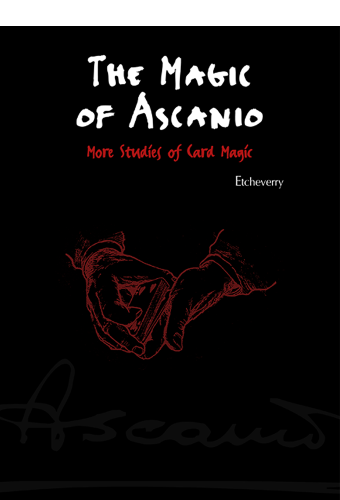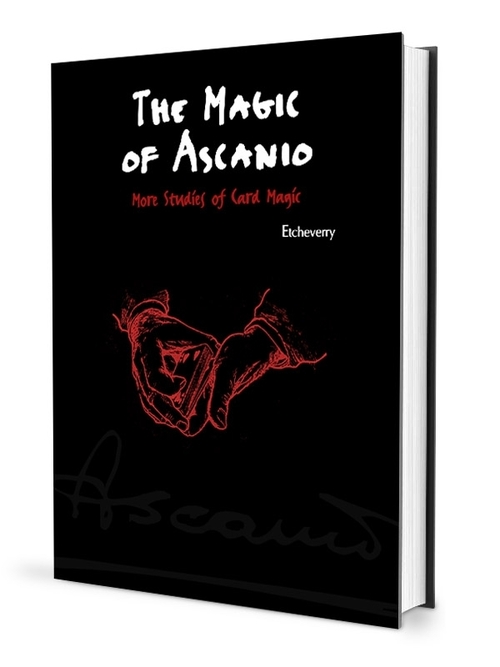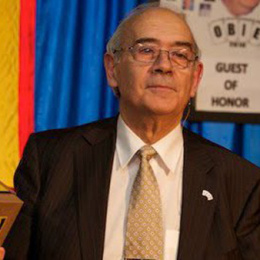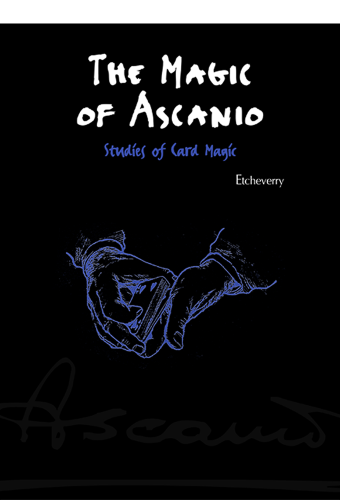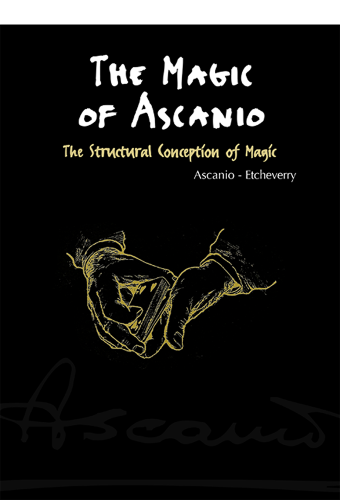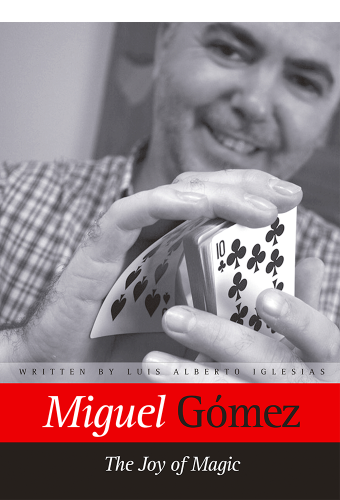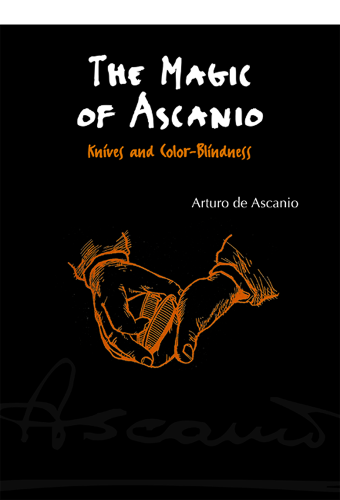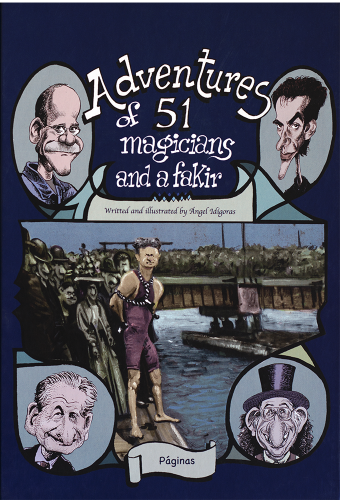The Magic of Ascanio. Volume 3 More Studies of Card Magic
Etcheverry/Ascanio
978-84-89749-69-669,00€
Año de Edición: 2008
Traducción: Rafael Benatar
Producción Gráfica: ilustraciones y fotografías: Jesús Almendro
454 pags.
Binding: hardcover
Format: 17cmx24cm
Arturo de Ascanio y Navaz (1926-1997), is regarded as the father of Spanish card magic. A lawyer by trade and an amateur magician, he devoted a good part of his life to magic and was one of the founders of the prestigious Escuela Mágica de Madrid.
The Structural Conception of Magic, which is the first volume of The Magic of Ascanio, is devoted to his theoretical thinking. Studies of Card Magic and More Studies of Card Magic include all of his card creations, while the fourth volume Knives and Color-Blindness is a treatise on magic with pocket knives.
The third volume includes some of his signature pieces like The Restless Lady, Alternating the Colors, and his legendary All-Backs routine. These routines were part of the act that Ascanio performed at the Amsterdam FISM Convention, where he won First Prize in Card Magic. Also included are his classics Sequacious Spades, and Cards Through the Table, The Ten Cards Up the Sleeve, The Aces of My Exam, Freddy Fah's Wallet, Mentalism by Elimination, The Magical Nine, Stranger Ambitious Card, and The Nudist Deck. The book ends with Black Days, a masterpiece of magical thinking, as Arturo himself described it.
Binding: hardcover
Format: 17cmx24cm
Arturo de Ascanio y Navaz (1926-1997), is regarded as the father of Spanish card magic. A lawyer by trade and an amateur magician, he devoted a good part of his life to magic and was one of the founders of the prestigious Escuela Mágica de Madrid.
The Structural Conception of Magic, which is the first volume of The Magic of Ascanio, is devoted to his theoretical thinking. Studies of Card Magic and More Studies of Card Magic include all of his card creations, while the fourth volume Knives and Color-Blindness is a treatise on magic with pocket knives.
The third volume includes some of his signature pieces like The Restless Lady, Alternating the Colors, and his legendary All-Backs routine. These routines were part of the act that Ascanio performed at the Amsterdam FISM Convention, where he won First Prize in Card Magic. Also included are his classics Sequacious Spades, and Cards Through the Table, The Ten Cards Up the Sleeve, The Aces of My Exam, Freddy Fah's Wallet, Mentalism by Elimination, The Magical Nine, Stranger Ambitious Card, and The Nudist Deck. The book ends with Black Days, a masterpiece of magical thinking, as Arturo himself described it.
Table of Contents
A Word From the Publisher
Introduction by Camilo Vázquez
Foreword in Three Acts
Act One, by Toni Cachadiña
Act Two, by Joan Font
Act Three, by Manolo Tena
Chapter One: His Classics
The Restless Lady
First Version (1970)
The Tenkai Turnover
Second Version (ca. 1981)
Third Version (ca. 1985)
The Nail Twist
Fourth and Last Version (ca. 1995)
Alternating the Colors
The Haphazard Shuffle
All-Backs
Impromptu Version
Appendix: Resealed (Joan Font)
Ascanio on Daley
The Ten Cards Up the Sleeve
Covering the Bottom Palm
Covering the One-Hand Spring Palm
Covering the Left One-Hand Bottom Palm
The Ascanio Ten Palm
Mentalism by Elimination: That Trick
The Change and Reverse Gear Shuffle
Sequacious Spades: The Veil of the Night
Impromptu Version
Cards Through the Table (The Hamman/Kaps Kings)
Freddy Fah's Wallet
The Magical Nine
Baiting Actions
Ascanio's Handling of the Hamman Count
D'Amico's Replacement
Chapter Two: The Stanley Collins Aces
Aces for Connoisseurs: Salute to Fred Kaps
The Aces of My Exam
Chapter Three: The Ambitious Card
The Ambitious Ace
One-Handed Preparation for Vernon�s Depth Illusion
Appendix: The Twirl (Jerry Andrus)
Double Ambitious: The Seventh Heaven
Ascanio�s Crimp
The Trueba Revolving Replacement
The Challenging Double
The Acrobatic Double
The Ascanio Half-a-Double Palm
Stranger Ambitious Card
The Jerry Andrus Replacement
The One Against Fifty-One Double Cut
The Matt Corin Transformation
Chapter Four: The Nudist Deck
Nudist Cards: The 1949 Version
Nudist Cards: The 1956 Version
Covering the Half Pass
Nudist Cards: Latest Version
The Ascanio Spread Cut
Ascanio's Beveling Square-Up
Chapter Five: Blue, Red, White
Blue, Red, White: A Constructional Study
Chapter Six: Paul Curry's Out of This World
Paul Curry's Out of This World
Chapter Seven: Assorted Tricks
Nomad Aces
Aces Vegas Style
The Trick of the Wise
Ascanio Visits Jennings
Chapter Eight: Sleights and Applications
The Le Temps Change
Magical Coincidences
Five Red and Five Black
Deception Through Timing
In-Transit Actions in the Elmsley Count
In-Transit Actions in the Hamman Count
Thoughts on the Double Lift
Hitting the Double
The Ascanio Double Turnover
A Prepared Double
The Return Turnover
A Diminishing Lift Sequence
Transformations in Beauty
Double Transformation
A Single Transformation
The Vanish and Reappearance of the Ace of Hearts
Credential Cards
Chapter Nine: Black Days
Black Days (Ascanio's Version of a Trick by Juan Tamariz)
[written by Ascanio]
Modus Operandi
I. Evolution of the Trick and Various Anecdotes
II. Set-Up
III. Procedure
IV. How to Proceed if the Thought-of Card is Guessed Correctly
V. How to Perform the Trick Standing
VI. How to Proceed if you Forget the Card
Sleights Used in Black Days
I. The Arnaldo Shuffle
II. The TaHa Cut
III. The Power Color Change
IV. The Almost Pinkieless Maneuver
V. On the Execution of the Le Temps Change
VI. Variations of the One Against Fifty-One Double Cut
VII. The Kaps Lapping Move
VIII. The Weightless Double Turnover (The Reinvented Double)
The Psychological Aspects of Black Days
I. Construction
I.1. Phases of a Trick
I.2. Other Constructional Aspects
I.3. Actions of Apparent Continuity
I.3.1. Structure
I.3.2. Features and Requirements
I.3.3. Results
I.3.4. Creating Actions of Apparent Continuity
II. Presentation
II.1. Patter
II.2. The Hinting Phase
II.3. Poetry and the Young
II.4. Other Broken-Hearted Verses
III. Cover
III.1. Mental Resources
III.1.1. Mental Fixation
III.1.2. Degrees of Deceptiveness
III.2. Cover Through In-Transit Actions
III.3. Cover for the Kaps Lapping Move
III.3.1. False Actions and Secret Actions
III.3.2. Covering the Move
III.4. Cover for the Le Temps Change
III.4.1. Cover Through Diluted Attention
III.4.2. Cover Through the Tube Effect
Suum Cuique Tribuere (Credit Where It's Due)
Epilogue
A Word From the Publisher
Introduction by Camilo Vázquez
Foreword in Three Acts
Act One, by Toni Cachadiña
Act Two, by Joan Font
Act Three, by Manolo Tena
Chapter One: His Classics
The Restless Lady
First Version (1970)
The Tenkai Turnover
Second Version (ca. 1981)
Third Version (ca. 1985)
The Nail Twist
Fourth and Last Version (ca. 1995)
Alternating the Colors
The Haphazard Shuffle
All-Backs
Impromptu Version
Appendix: Resealed (Joan Font)
Ascanio on Daley
The Ten Cards Up the Sleeve
Covering the Bottom Palm
Covering the One-Hand Spring Palm
Covering the Left One-Hand Bottom Palm
The Ascanio Ten Palm
Mentalism by Elimination: That Trick
The Change and Reverse Gear Shuffle
Sequacious Spades: The Veil of the Night
Impromptu Version
Cards Through the Table (The Hamman/Kaps Kings)
Freddy Fah's Wallet
The Magical Nine
Baiting Actions
Ascanio's Handling of the Hamman Count
D'Amico's Replacement
Chapter Two: The Stanley Collins Aces
Aces for Connoisseurs: Salute to Fred Kaps
The Aces of My Exam
Chapter Three: The Ambitious Card
The Ambitious Ace
One-Handed Preparation for Vernon�s Depth Illusion
Appendix: The Twirl (Jerry Andrus)
Double Ambitious: The Seventh Heaven
Ascanio�s Crimp
The Trueba Revolving Replacement
The Challenging Double
The Acrobatic Double
The Ascanio Half-a-Double Palm
Stranger Ambitious Card
The Jerry Andrus Replacement
The One Against Fifty-One Double Cut
The Matt Corin Transformation
Chapter Four: The Nudist Deck
Nudist Cards: The 1949 Version
Nudist Cards: The 1956 Version
Covering the Half Pass
Nudist Cards: Latest Version
The Ascanio Spread Cut
Ascanio's Beveling Square-Up
Chapter Five: Blue, Red, White
Blue, Red, White: A Constructional Study
Chapter Six: Paul Curry's Out of This World
Paul Curry's Out of This World
Chapter Seven: Assorted Tricks
Nomad Aces
Aces Vegas Style
The Trick of the Wise
Ascanio Visits Jennings
Chapter Eight: Sleights and Applications
The Le Temps Change
Magical Coincidences
Five Red and Five Black
Deception Through Timing
In-Transit Actions in the Elmsley Count
In-Transit Actions in the Hamman Count
Thoughts on the Double Lift
Hitting the Double
The Ascanio Double Turnover
A Prepared Double
The Return Turnover
A Diminishing Lift Sequence
Transformations in Beauty
Double Transformation
A Single Transformation
The Vanish and Reappearance of the Ace of Hearts
Credential Cards
Chapter Nine: Black Days
Black Days (Ascanio's Version of a Trick by Juan Tamariz)
[written by Ascanio]
Modus Operandi
I. Evolution of the Trick and Various Anecdotes
II. Set-Up
III. Procedure
IV. How to Proceed if the Thought-of Card is Guessed Correctly
V. How to Perform the Trick Standing
VI. How to Proceed if you Forget the Card
Sleights Used in Black Days
I. The Arnaldo Shuffle
II. The TaHa Cut
III. The Power Color Change
IV. The Almost Pinkieless Maneuver
V. On the Execution of the Le Temps Change
VI. Variations of the One Against Fifty-One Double Cut
VII. The Kaps Lapping Move
VIII. The Weightless Double Turnover (The Reinvented Double)
The Psychological Aspects of Black Days
I. Construction
I.1. Phases of a Trick
I.2. Other Constructional Aspects
I.3. Actions of Apparent Continuity
I.3.1. Structure
I.3.2. Features and Requirements
I.3.3. Results
I.3.4. Creating Actions of Apparent Continuity
II. Presentation
II.1. Patter
II.2. The Hinting Phase
II.3. Poetry and the Young
II.4. Other Broken-Hearted Verses
III. Cover
III.1. Mental Resources
III.1.1. Mental Fixation
III.1.2. Degrees of Deceptiveness
III.2. Cover Through In-Transit Actions
III.3. Cover for the Kaps Lapping Move
III.3.1. False Actions and Secret Actions
III.3.2. Covering the Move
III.4. Cover for the Le Temps Change
III.4.1. Cover Through Diluted Attention
III.4.2. Cover Through the Tube Effect
Suum Cuique Tribuere (Credit Where It's Due)
Epilogue
With the words “Here’s to you, Maestro!” Jesús Etcheverry gave way to Arturo’s voice in Volume One of this work, which is already—as Juan and Miguel predicted in their respective forewords—a classic.
Now, only a year later, Jesús completes the trilogy with this text titled “More Studies of Card Magic,” with more classics of the master.
The complete trilogy is as surprising as it is overwhelming, and very different from anything that exists in the literature of magic. Aside from including virtually all of Ascanio’s output, the trilogy is enriched with countless details about how each creation came to be, including antecessors, variants, as well as the recounting of memorable moments when they were performed.
Many of the sleights employed by Arturo are described in detail with insights about their origins, and with the accuracy and depth that were a feature of his explanations. Also included are Ascanio’s theoretical principles—his thinking, and his concepts that have left a mark in the structure of modern card magic. These are complemented by more colloquial explanations in the transcription of live lectures, enriched by Arturo’s casual comments in a warm and human style.
These not only include the objective aspects of his magic such as effects, technique, and theory, but also intimate, subjective ones related to Arturo’s personal approach to the art, like his moving and sincere testimonial in one of the Escorial gatherings: “Daley in Heaven.”
The Magic of Ascanio not only contains Ascanio’s magic but Arturo is alive within its pages. Those of us who were fortunate to meet him; to talk to him; to enjoy his friendship and benefit from his knowledge; to experience the emotion of watching his effects for the first time; to enjoy the aesthetic emotion, the beauty and perfection of his handling; and to listen to his patter, will always see and hear Arturo. His voice and his presence will accompany our reading.
Those discovering Arturo through these books will also experience the magical sensation of having met him. That’s the magic of Jesús Etcheverry.
Camilo Vázquez
Maisons Laffitte. August, 2001
*******
Foreword in Three Acts
Act One, by Toni Cachadiña
I was lucky enough to enjoy Arturo’s endearing friendship and magic without even being aware that I was living historical moments. Over the years, I began to realize the benefits of having developed in magic next to him and his wise teachings.
Rather than elaborating about Ascanio, the man, I’ll be pleased to recount some of those moments spent together, when he would tell me little things that were as big as his heart, as well as his need for offering us his wisdom.
The first time I heard of Ascanio was upon my arrival at the SEI (Sociedad Española de Ilusionismo) in 1959. It was like hearing of somebody from outer space. Well-established magicians called him Maestro while, for the novice that I was, there was no way to appreciate the meaning of that word because everything I learned seemed like a genuine miracle.
Once I became a part of the Barcelona close-up scene, we began to receive privy information from Madrid. Ascanio would mail us write-ups of routines he had already studied, at a time when it was not easy to get hold of newly published material. Now we realize that we were isolated but we had good connections. It was such a joy to have access to routines like Mohammed Bey’s for the Okito Box or Hamman’s Final Aces, among so many others. We are talking about 1960, when our enthusiasm had the privilege of being nurtured by the great Ascanio.
Later, my good friends and mentors Pablo Doménech and Ricardo Marré invited me to join an afternoon session at which Ascanio was present. My first magic session, and what a session it was! What a discovery! My eyes opened widely and so did the doors to a new world.
The good fortune of having spent time with Ascanio and having learned directly from him is one the greatest joys magic has given me. I hope those who never got to meet Arturo will get to know him thoroughly and absorb his wisdom through this monumental work.
I don’t want to end without stressing the value of the work of Jesús Etcheverry. It’s a labor of love for the art of magic and for the legacy of Arturo de Ascanio. Such devotion has led our friend Jesús to compile everything that Arturo left in a trilogy that will become an instant classic of card magic and of the theory of magic.
Act Two, by Joan Font
When Jesús Etcheverry offered me the honor of writing these words, I felt thrilled and flattered, knowing that the many things that could be told about Arturo and his magic were all very good. I soon understood, however, that neither my magical background nor my writing skills would qualify me for praising Arturo’s unparalleled thoroughness on the art, which was worthy of the best writing.
Despite all that, I didn’t want to refuse the honor of contributing my little grain of sand by talking about Arturo’s qualities as a person, which was no less than those he possessed as a magician.
Arturo was extroverted, kind, and endearing. He would never hold back applause or words of praise for anyone. On the contrary, he had the tendency to exaggerate his appreciation to encourage somebody to improve.
He spared no effort to find the way to “empty” himself—as he liked to say—to others, only to fill himself up again with more subtleties, details, in his drive toward perfection.
Contribute, communicate, and teach: these were some of Ascanio’s favorite verbs, and he lived to exercise them. His controlled temper only surfaced to defend a cause, a friend, or a situation in which magic or magicians were not duly respected.
Only by seeing him as a constant and self-demanding worker, can we understand his success and his achievements. How many hours he would spend in solitude to refine details, sleights and moves! I remember the day we discussed the solitude toward which I felt sympathetic, and he said: “It’s only an apparent solitude, because the applause heard during study and practice are there, in the magicians that enjoy my success and my experiences, in those who attain success performing one of the tricks you manufacture, or with the patter of your routines, Joan. Believe me, it’s an apparent solitude.”
Now I understand, Arturo. You were never and will never be alone. Magic gave you several spiritual sons—as you liked to call them—and also many friends that are here to further portray your teachings, your generosity, and your love for magic.
Among all of these, let me single out Jesús Etcheverry, the author of this work, who through his painstaking thoroughness, has managed to gather everything that Arturo would have cared to publish, paying a tribute to somebody who devoted an entire life, and a fruitful one, to magic.
Act Three, by Manolo Tena
Why should we read Ascanio? Or, above all, why should we study Ascanio? Well, there are two fundamental reasons: for pleasure and for seeking knowledge.
If I visit Cuenca, for business or for pleasure, it is mandatory to visit the Diocesan Museum. The line of visitors through the Vault Chamber, requires a slow approach toward the unforgettable view of Jesus Christ as painted by El Greco. As you get closer, you gradually discover the technique, until you are literally exhausted and find a patch of white paint where you had earlier seen an overwhelming reflection.
The blinding beauty of Ascanio’s magic, so accurately reflected in The Conception of the Magical Atmosphere, conceals a whole world of technique at its service. To walk the path from beauty to technique is an inexhaustible stream of pleasure, and to pilgrim in the opposite direction is to reach the fountain of magical knowledge.
In Ascanio’s work you can walk through it either way. There is no other such case. It is pure joy and wisdom. It’s inevitable to read Ascanio and it is a must to study his work.
I congratulate you, dear reader, for having this book in your hands. Through this trilogy you’ll understand magic better, and through magic you will understand art better.
I got started along this path many years ago, when I attended a substantial lecture on the Zingone Spread. I can still hear the words: Ascanio, come over here. I want you to meet this kid, who is hooked on you…
Now, only a year later, Jesús completes the trilogy with this text titled “More Studies of Card Magic,” with more classics of the master.
The complete trilogy is as surprising as it is overwhelming, and very different from anything that exists in the literature of magic. Aside from including virtually all of Ascanio’s output, the trilogy is enriched with countless details about how each creation came to be, including antecessors, variants, as well as the recounting of memorable moments when they were performed.
Many of the sleights employed by Arturo are described in detail with insights about their origins, and with the accuracy and depth that were a feature of his explanations. Also included are Ascanio’s theoretical principles—his thinking, and his concepts that have left a mark in the structure of modern card magic. These are complemented by more colloquial explanations in the transcription of live lectures, enriched by Arturo’s casual comments in a warm and human style.
These not only include the objective aspects of his magic such as effects, technique, and theory, but also intimate, subjective ones related to Arturo’s personal approach to the art, like his moving and sincere testimonial in one of the Escorial gatherings: “Daley in Heaven.”
The Magic of Ascanio not only contains Ascanio’s magic but Arturo is alive within its pages. Those of us who were fortunate to meet him; to talk to him; to enjoy his friendship and benefit from his knowledge; to experience the emotion of watching his effects for the first time; to enjoy the aesthetic emotion, the beauty and perfection of his handling; and to listen to his patter, will always see and hear Arturo. His voice and his presence will accompany our reading.
Those discovering Arturo through these books will also experience the magical sensation of having met him. That’s the magic of Jesús Etcheverry.
Camilo Vázquez
Maisons Laffitte. August, 2001
*******
Foreword in Three Acts
Act One, by Toni Cachadiña
I was lucky enough to enjoy Arturo’s endearing friendship and magic without even being aware that I was living historical moments. Over the years, I began to realize the benefits of having developed in magic next to him and his wise teachings.
Rather than elaborating about Ascanio, the man, I’ll be pleased to recount some of those moments spent together, when he would tell me little things that were as big as his heart, as well as his need for offering us his wisdom.
The first time I heard of Ascanio was upon my arrival at the SEI (Sociedad Española de Ilusionismo) in 1959. It was like hearing of somebody from outer space. Well-established magicians called him Maestro while, for the novice that I was, there was no way to appreciate the meaning of that word because everything I learned seemed like a genuine miracle.
Once I became a part of the Barcelona close-up scene, we began to receive privy information from Madrid. Ascanio would mail us write-ups of routines he had already studied, at a time when it was not easy to get hold of newly published material. Now we realize that we were isolated but we had good connections. It was such a joy to have access to routines like Mohammed Bey’s for the Okito Box or Hamman’s Final Aces, among so many others. We are talking about 1960, when our enthusiasm had the privilege of being nurtured by the great Ascanio.
Later, my good friends and mentors Pablo Doménech and Ricardo Marré invited me to join an afternoon session at which Ascanio was present. My first magic session, and what a session it was! What a discovery! My eyes opened widely and so did the doors to a new world.
The good fortune of having spent time with Ascanio and having learned directly from him is one the greatest joys magic has given me. I hope those who never got to meet Arturo will get to know him thoroughly and absorb his wisdom through this monumental work.
I don’t want to end without stressing the value of the work of Jesús Etcheverry. It’s a labor of love for the art of magic and for the legacy of Arturo de Ascanio. Such devotion has led our friend Jesús to compile everything that Arturo left in a trilogy that will become an instant classic of card magic and of the theory of magic.
Act Two, by Joan Font
When Jesús Etcheverry offered me the honor of writing these words, I felt thrilled and flattered, knowing that the many things that could be told about Arturo and his magic were all very good. I soon understood, however, that neither my magical background nor my writing skills would qualify me for praising Arturo’s unparalleled thoroughness on the art, which was worthy of the best writing.
Despite all that, I didn’t want to refuse the honor of contributing my little grain of sand by talking about Arturo’s qualities as a person, which was no less than those he possessed as a magician.
Arturo was extroverted, kind, and endearing. He would never hold back applause or words of praise for anyone. On the contrary, he had the tendency to exaggerate his appreciation to encourage somebody to improve.
He spared no effort to find the way to “empty” himself—as he liked to say—to others, only to fill himself up again with more subtleties, details, in his drive toward perfection.
Contribute, communicate, and teach: these were some of Ascanio’s favorite verbs, and he lived to exercise them. His controlled temper only surfaced to defend a cause, a friend, or a situation in which magic or magicians were not duly respected.
Only by seeing him as a constant and self-demanding worker, can we understand his success and his achievements. How many hours he would spend in solitude to refine details, sleights and moves! I remember the day we discussed the solitude toward which I felt sympathetic, and he said: “It’s only an apparent solitude, because the applause heard during study and practice are there, in the magicians that enjoy my success and my experiences, in those who attain success performing one of the tricks you manufacture, or with the patter of your routines, Joan. Believe me, it’s an apparent solitude.”
Now I understand, Arturo. You were never and will never be alone. Magic gave you several spiritual sons—as you liked to call them—and also many friends that are here to further portray your teachings, your generosity, and your love for magic.
Among all of these, let me single out Jesús Etcheverry, the author of this work, who through his painstaking thoroughness, has managed to gather everything that Arturo would have cared to publish, paying a tribute to somebody who devoted an entire life, and a fruitful one, to magic.
Act Three, by Manolo Tena
Why should we read Ascanio? Or, above all, why should we study Ascanio? Well, there are two fundamental reasons: for pleasure and for seeking knowledge.
If I visit Cuenca, for business or for pleasure, it is mandatory to visit the Diocesan Museum. The line of visitors through the Vault Chamber, requires a slow approach toward the unforgettable view of Jesus Christ as painted by El Greco. As you get closer, you gradually discover the technique, until you are literally exhausted and find a patch of white paint where you had earlier seen an overwhelming reflection.
The blinding beauty of Ascanio’s magic, so accurately reflected in The Conception of the Magical Atmosphere, conceals a whole world of technique at its service. To walk the path from beauty to technique is an inexhaustible stream of pleasure, and to pilgrim in the opposite direction is to reach the fountain of magical knowledge.
In Ascanio’s work you can walk through it either way. There is no other such case. It is pure joy and wisdom. It’s inevitable to read Ascanio and it is a must to study his work.
I congratulate you, dear reader, for having this book in your hands. Through this trilogy you’ll understand magic better, and through magic you will understand art better.
I got started along this path many years ago, when I attended a substantial lecture on the Zingone Spread. I can still hear the words: Ascanio, come over here. I want you to meet this kid, who is hooked on you…

